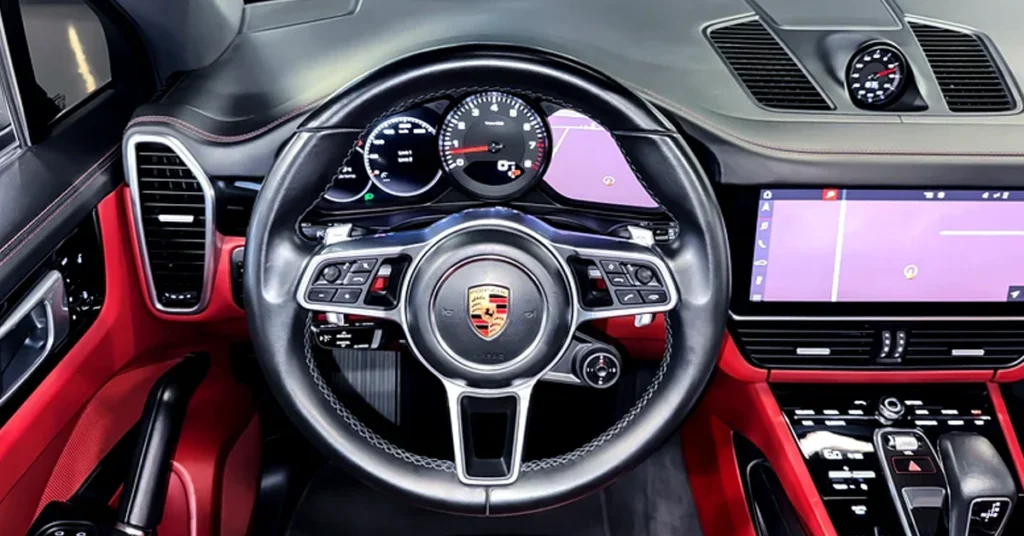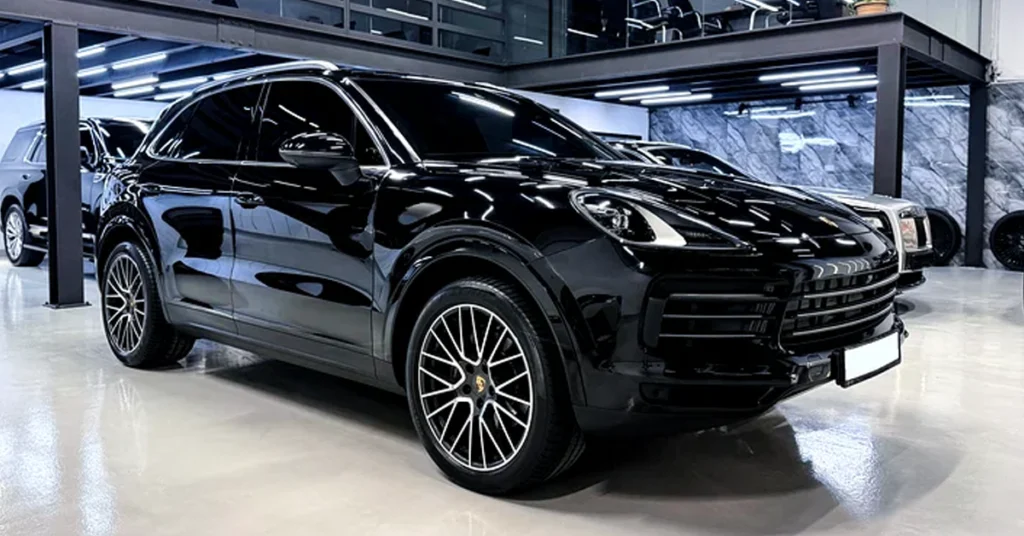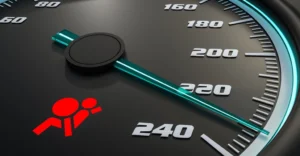Few luxuries SUVs balance badge prestige, performance, and daily usability quite like the Porsche Cayenne. Since its third-generation debut in 2018 (technically MY2019), this big Porsche has evolved from an eyebrow-raising oddity to a benchmark for how an SUV should feel from behind the wheel.
Today, as the earliest examples dip below the cost of a new compact saloon, the used Cayenne has become a compelling buy for enthusiasts who refuse to compromise on driving engagement even when ferrying kids, shopping, and golf clubs.
A Quick Background: When Porsche Perfected the SUV Formula
The third-gen Cayenne marked a significant evolution from its predecessor. Built on the Volkswagen Group’s MLB Evo platform shared with the Audi Q7, Bentley Bentayga, and Lamborghini Urus it delivered the refinement and tech those nameplates are known for, with Porsche’s unique DNA layered on top.
In the 2019–present range, buyers could choose from several variants: the base 3.0-litre V6, the muscular Cayenne S with a 2.9-litre twin-turbo V6, the bonkers V8-powered Turbo, and the E-Hybrid. Each model came with all-wheel drive, an eight-speed Tiptronic automatic, and Porsche’s uncanny ability to disguise mass with engineering precision.
A facelift arrived for 2024, tweaking the front end, interior screens, and hybrid tech but the 2019-2023 cars remain sweet-spot buys for their blend of mechanical feel and lower depreciation.
Driving and Performance: Still the Driver’s SUV
The Cayenne has long been the go-to SUV for those who still care about how their car corners. Even in its base trim, it feels balanced, agile, and poised traits more often associated with sports saloons than 2-tonne SUVs.
The steering is pure Porsche: quick, natural, and weighted perfectly. The suspension (steel as standard, air optional) isolates road imperfections while keeping body roll firmly in check. On winding roads, the Cayenne genuinely shrinks around you.
The Cayenne S adds real muscle with its twin-turbo V6 pushing around 440 PS, enough for a 0–100 km/h sprint in just over 5 seconds. The Turbo, meanwhile, is a brute in a tuxedo with a thunderous 550 PS V8 and a soundtrack that feels more GT car than SUV.
The E-Hybrid deserves a brief mention: it combines a 3.0-litre V6 with an electric motor for 462 PS, and around 40 km of electric-only range. In real-world UAE traffic, that’s enough for short commutes or school runs on battery power alone, but it adds weight and complexity compared to the ICE models.
Comfort and Technology: Quiet Luxury, Porsche-Style

Slip into the Cayenne’s cabin and you’ll immediately sense its driver-centric ethos. The dashboard wraps neatly around the cockpit, featuring high-quality materials leather, aluminium, and, depending on spec, carbon or wood trim.
Later models introduced the Porsche Communication Management (PCM) system with a crisp 12.3-inch touchscreen, configurable driver display, and smartphone integration. Even early third-gen cars feel modern, though the pre-facelift models lack the newer curved display now found in the 2024 update.
Comfort is another strong suit. The seats are firm yet perfectly contoured, offering long-distance support. Rear space is generous, and the boot at 770 litres is among the best in class. Air suspension (if fitted) can raise or lower the ride height, making loading or off-roading easier.
Optional extras like ventilated seats, Burmester audio, and night vision make the Cayenne feel every inch a six-figure luxury SUV, even on the used market.
Recommended Model Years and Which to Avoid
If you’re buying used, model-year choice matters. Early production cars (especially 2019 models) sometimes suffered from teething issues mainly minor electrical gremlins, infotainment lags, and occasional sensor faults that Porsche later ironed out.
The 2020 and 2021 model years represent the sweet spot early enough to avoid steep depreciation, yet late enough to benefit from Porsche’s software refinements and improved build consistency.
Recommended years:
- 2020–2022 Cayenne S or base V6: solid reliability, strong resale value, and broad parts availability.
- 2021 E-Hybrid: ideal if you want the hybrid without early-batch battery calibration bugs.
Years to avoid (if possible):
- 2019 (early production) occasional electronics and PCM system glitches.
- High-mileage Turbos (2019–2020) some have expensive suspension or cooling repairs looming.
In short: buy 2020 onwards with full-service history, and you’ll enjoy the Cayenne experience with minimal drama.
Reliability and Ownership Costs: What to Watch For
No Porsche is cheap to maintain, and the Cayenne is no exception. However, it’s generally more reliable than many rivals, particularly if properly serviced. The engines and transmissions are robust, and the V6 models tend to be the least troublesome.
Common issues on earlier third-gens include:
- Minor electrical glitches with infotainment and sensors
- Air suspension leaks on high-mileage cars
- Brake wear (they’re big, and parts aren’t cheap)
- E-Hybrid battery degradation over time not catastrophic, but worth checking
Routine maintenance costs more than on a BMW X5 or Mercedes GLE, but Porsche’s build quality pays back in durability and resale. Servicing through specialists like MotorHub UAE can significantly reduce running costs compared with dealership rates.
Fuel economy isn’t its strong point expect around 10–12 L/100 km on the V6, and more on the V8 but that’s the price for performance and weight. The E-Hybrid helps here but trades simplicity for efficiency.
The Comparison: How the Cayenne Stacks Up
Below is a quick reference for buyers cross-shopping rival SUVs. Figures represent typical real-world impressions rather than brochure claims.
| Model | Performance | Reliability | Comfort | Tech | Resale Value |
| Porsche Cayenne (2019–2023) | ★★★★★ (Best-in-class dynamics) | ★★★★☆ | ★★★★☆ | ★★★★☆ | ★★★★★ |
| BMW X5 (G05) | ★★★★☆ (Sharp, refined) | ★★★★☆ | ★★★★☆ | ★★★★★ | ★★★★☆ |
| Range Rover Sport (L494) | ★★★★☆ (Strong but heavy) | ★★☆☆☆ | ★★★★★ | ★★★★☆ | ★★★★☆ |
| Mercedes-Benz GLE (W167) | ★★★★☆ (Smooth, luxurious) | ★★★★☆ | ★★★★★ | ★★★★★ | ★★★★☆ |
| Audi Q7 (4M) | ★★★☆☆ (Composed but less engaging) | ★★★★☆ | ★★★★☆ | ★★★★☆ | ★★★★☆ |
Across categories, the Cayenne remains the driver’s choice, especially for those who prioritise feedback and steering precision. It may lack the limousine calm of the GLE or the outright plushness of the Range Rover Sport, but when it comes to engagement and long-term desirability, it stands above.
Editor’s Verdict
The third-generation Cayenne proves that Porsche hasn’t forgotten how to make a car feel alive. It’s an SUV that flatters its driver, soothes passengers, and ages gracefully both mechanically and aesthetically.
Yes, it costs more to run than a mainstream alternative, but what you get in return is a level of dynamic polish that few SUVs, even today, can replicate.
The sweet spot? A Cayenne S with air suspension and a full Porsche service history. It delivers 90 per cent of the Turbo’s excitement with far fewer ownership headaches.
If you want an SUV that genuinely feels engineered, not just assembled, the used Cayenne remains the benchmark.
MotorHub UAE Recommendation
If you’re considering a used Porsche Cayenne in the UAE, let MotorHub take the guesswork out of it.
Our specialists can connect you with trusted garages for pre-purchase inspections, battery and suspension diagnostics, and genuine-parts servicing at transparent rates.
From oil changes to hybrid system maintenance, MotorHub ensures your Cayenne performs exactly as Porsche intended whether it’s cruising Sheikh Zayed Road or heading out to the desert.



